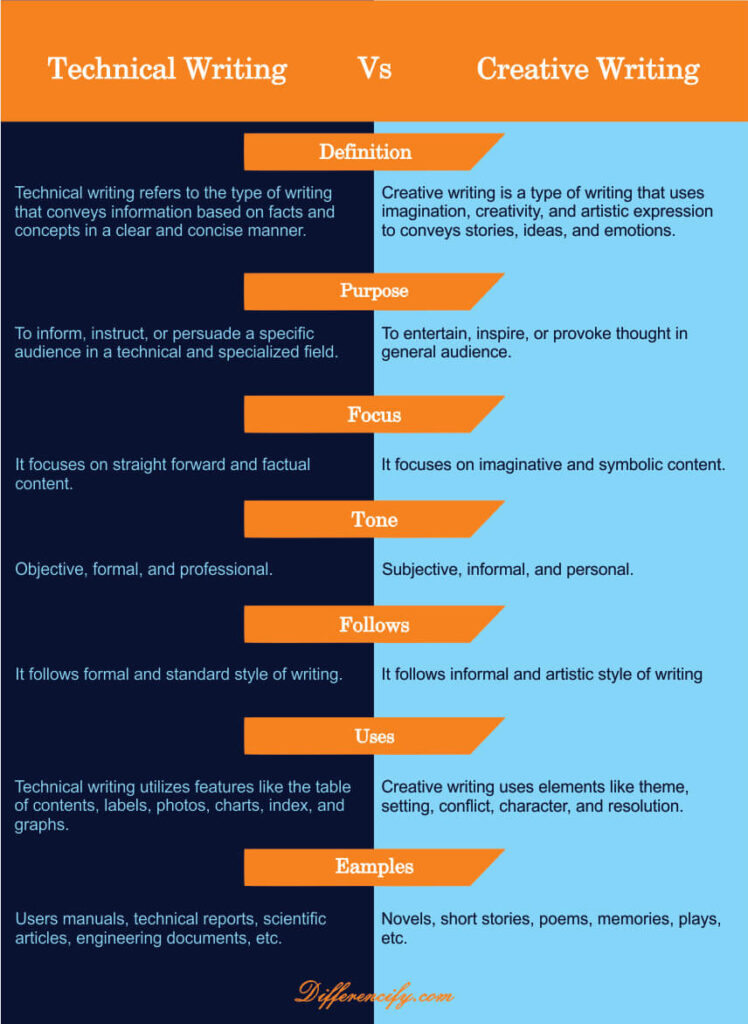Writing is a form of communication that allows individuals to convey their ideas, thoughts, and emotions to others. There are many different types of writing, each with its unique style, purpose, and audience. Two common types of writing are technical and creative writing. While both forms require the ability to write well, they differ significantly in terms of their content, structure, and style. So, in this article, we will get to have a look at the complete difference between technical vs creative writing with the help of a table and different key points.
Technical Vs Creative Writing (Comparison Table)
| Technical Writing | Creative Writing |
|---|---|
| Technical writing refers to the type of writing is a type of writing that conveys based on facts and concepts in a clear and concise manner. | Creative writing is a type of writing that uses imagination, creativity, and artistic expression to convey stories, ideas, and emotions. |
| The purpose of technical writing is to inform, instruct, or persuade a specific audience in a technical or specialized field. | The main purpose of creative writing is to entertain, inspire, or provoke thought in a general audience. |
| It focuses on straightforward and factual content. | It focuses on imaginative and symbolic content. |
| The tone of technical writing is objective, formal, and professional. | The tone of creative writing is subjective, informal, and personal. |
| It follows a formal and standard style of writing. | It generally follows an informal and artistic style of writing. |
| Technical writing utilizes some features such as tables of contents, labels, photos, charts, indexes, and graphs. | Creative writing uses elements like theme, setting, conflict, character, and resolution. |
| Some examples of technical writing include user manuals, technical reports, scientific articles, engineering documents, etc. | Examples of creative writing include novels, short stories, poems, memories, plays, etc. |
You Can Also Read:
What is technical Writing?
Technical writing refers to writing that is intended to convey technical information or instructions to a specific audience. It is commonly used in fields such as engineering, medicine, science, and technology, where precise and accurate communication is essential. Technical writing typically involves the use of jargon, technical terms, and formal language to convey complex information.
Examples of technical writing include user manuals, instruction manuals, product specifications, research reports, and scientific papers. Technical writers use their expertise in a particular subject matter to create clear and concise documents that are easy to understand for a specific audience.
Characteristics of Technical Writing
Following are some of the main characteristics of technical writing.
- Clarity: Technical writing is characterized by its clarity and precision. This means that technical writing uses simple and straightforward language to convey complex ideas and information. It avoids unnecessary jargon, slang, or colloquialisms that could confuse or mislead the reader.
- Objectivity: Technical writing is objective and factual. Technical writers are expected to present information in an unbiased and impartial way, without personal opinions or emotions. This means that technical writing focuses on the facts and evidence to support its claims, and avoids speculation or conjecture.
- Accuracy: Technical writing is characterized by its accuracy and attention to detail. Technical writers must ensure that all information presented is correct and up-to-date. They must verify their sources and use reliable data and information to support their writing.
- Purpose-Driven: Technical writing is always purpose-driven. It serves a specific function or goal, whether it is to instruct, explain, persuade, or inform. Technical writers must understand their audience and tailor their writing to meet their needs and expectations. They must also be able to anticipate potential questions or objections and provide answers or solutions to address them.
- Structured: Technical writing is structured and organized. It follows a logical sequence and presents information in a clear and consistent manner. Technical writers often use headings, bullet points, tables, and diagrams to help readers navigate complex information and understand the relationships between different ideas.
What is Creative Writing?
Creative writing, on the other hand, refers to writing that is intended to entertain, inspire, or provoke an emotional response from the reader. It is often used in literature, poetry, and other forms of artistic expression. Creative writing focuses on using language in unique and imaginative ways to convey emotions, ideas, and experiences.
Examples of creative writing include novels, short stories, poems, plays, and screenplays. Creative writers use their creativity and imagination to create unique stories that engage and captivate their readers.
key Differences Between Technical and Creative Writing
While comparing technical vs creative writing, here we have included some of the key differences between them as well. So let’s have a look at them.
- Meaning: Technical writing refers to the type of writing is a type of writing that conveys based on facts and concepts in a clear and concise manner. On the other hand, Creative writing is a type of writing that uses imagination, creativity, and artistic expression to convey stories, ideas, and emotions
- Purpose: The primary purpose of technical writing is to convey technical information or instructions to a specific audience. Technical writers aim to explain complex concepts or procedures in a clear and concise manner. Creative writing, on the other hand, is intended to entertain, inspire, or provoke an emotional response from the reader.
- Audience: Technical writing is typically written for a specific audience, such as engineers, scientists, medical professionals, or students. The audience for technical writing is often familiar with the subject matter and requires precise and accurate information. Creative writing, on the other hand, is written for a broader audience, including general readers who are looking for entertainment or inspiration.
- Language and Style: Technical writing uses formal language, jargon, and technical terms to convey complex information. Technical writers focus on using clear and concise language that is easy to understand for their specific audience. Creative writing, on the other hand, uses more imaginative and figurative language to create a unique and engaging story.
- Structure: Technical writing typically follows a structured format that includes headings, subheadings, and bullet points. The structure of technical writing is intended to make the information easy to understand and follow. Creative writing, on the other hand, has more flexibility in terms of structure and may not follow a specific format.
- Creativity: Technical writing requires creativity in terms of presenting complex information in a clear and concise manner, but it does not focus on artistic expression. Creative writing, on the other hand, is all about artistic expression and requires a high level of creativity to create unique and engaging stories.
- Feedback and Revision: Technical writing often involves feedback and revision from subject matter experts or reviewers to ensure that the information is accurate and complete. Creative writing may involve feedback and revision from editors or other writers, but the focus is on artistic expression rather than technical accuracy.
The following table also shows the difference between technical and creative writing.

Features for Good Piece of Creative Writing
A good piece of creative writing is one that effectively communicates the author’s ideas and emotions while engaging and captivating the reader. There are several key elements that contribute to a good piece of creative writing, including:
- Strong Character Development: The characters in a good piece of creative writing should be well-rounded, multi-dimensional, and believable. They should have a clear backstory, motivation, and flaws that make them relatable to the reader.
- A Well-Crafted Plot: The plot of a good piece of creative writing should be well-structured, with a clear beginning, middle, and end. It should be engaging and keep the reader interested throughout the story.
- Vivid Descriptions: The use of descriptive language is essential in creative writing. A good piece of creative writing should have vivid descriptions that bring the story and characters to life in the reader’s mind.
- A Unique Perspective: A good piece of creative writing should offer a unique perspective or point of view on a particular topic or theme. It should challenge the reader’s assumptions and offer a fresh perspective on a familiar subject.
- Effective Use of Language: A good piece of creative writing should use language in imaginative and figurative ways. It should have a clear and consistent voice, use literary devices such as metaphor and simile, and create a rich and immersive world for the reader to explore.
- Emotional Impact: A good piece of creative writing should evoke emotions in the reader, whether it be joy, sadness, anger, or empathy. It should leave a lasting impression on the reader and be memorable long after they have finished reading it.
Overall, a good piece of creative writing is one that effectively communicates the author’s ideas and emotions while engaging and captivating the reader through strong character development, a well-crafted plot, vivid descriptions, a unique perspective, effective use of language, and emotional impact.
Conclusion
So, to sum up, this article, we can say that, technical and creative writing are two distinct forms of writing that require different skills and approaches. Technical writing focuses on conveying technical information or instructions in a clear and concise manner to a specific audience. On the other hand, creative writing focuses on using language in unique and imaginative ways to entertain, inspire, or provoke an emotional response from the reader.
Understanding the differences between these two forms of writing is essential for anyone who wants to excel in either field. While both types of writing have their unique challenges and rewards, individuals can choose the form that best suits their skills, interests, and career goals. Whether you are a technical writer or a creative writer, developing strong writing skills and adapting to the needs of your audience is essential for success in any writing career.
Reference For:




2 Comments